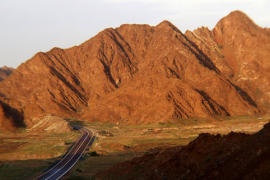The United Arab Emirates (UAE) operates the Emirate of Ras Al Khaimah. This was the final state to join the UAE, joining latterly in 1972.
The history of this state is both fascinating and diverse, and boasts a remarkable archaeological heritage along with a rich cultural history, and is one of the oldest continuously inhabited regions in the world.
Ras Al Khaimah’s beauty is astounding – scenic mountains, desert landscapes, and white beaches and (now rarely seen) mangroves, combine to attract humanity, and indeed it has for thousands of years. Its strategic location, at the mouth of the Arabian Gulf has made it a prime position for cultural and trading opportunities throughout history. Archaeologists have discovered evidence that trade has been established as far back as 5000 years BC. The state has variously been named Julfar, Majan and Al Seer, and was renowned for its commercial activity, throughout the Gulf. There is evidence to show that from the 10th century the inhabitants were trading as far afield as China, Bombay and Zanzibar, and due to its ultimate prosperity, made it a prime target for various invading powers. The remains of 18 historic castles, towers and fortresses, testify to its catastrophic and turbulent history. Invading forces included the Sassanid Persians, various Islamic clans of the Arabian Gulf, and also the Portuguese, Dutch and British colonial empires, bringing much bloodshed to the indigenous people of Ras Al Khaimah. For the history buff, Ras Al Khaimah offers many exciting prospects.



